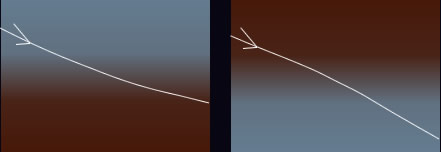 |
 |
 |
| Moonrise over Lower Tatras Mountains Lech Lobodzinski captured this bizarre moonrise at 1324m altitude on Lysa Hora Mountain in Czech Republic. He had gone there to observe the morning twilight colours. The last thin crescent of the old moon twists and seemingly drifts away in the wind as it climbs over the Lower Tatras Mountains. ©Lech Lobodzinski, shown with permission. |
 |
 |
 |

| About - Submit | Optics Picture of the Day | Galleries | Previous | Next | Today |
| Mirages and distortions are produced when the rays of a low sun or moon pass through atmospheric regions where there are strong temperature gradients. Temperature per se has no direct effect but a vertical temperature gradient is also a density gradient. Light rays slanting downward into a higher density air layer are refracted more sharply down making the object appear higher. Rays entering a warmer layer are refracted slightly upwards. A layer of warmer air beneath cooler produces an 'omega' or 'Etruscan vase' sun/moon. A second image is below the �real� sun or moon and rises as the real one descends. A temperature inversion, a kink in the normal atmospheric temperature variation with increasing height, has more complex effects. When the temperature gradients are strong there are at least three images, two erect and one inverted. Winds blowing across mountains introduce yet more effects. What temperature profile produced this moonrise? It is hard to say. But a strange and memorable sight. |
